Ever wondered how to transform your ordinary rectangular photos into eye-catching circular images? Whether you’re updating your social media profiles or working on a creative project, learning to crop a circle from your pictures can make a huge difference. The process is much simpler than you might think, and this comprehensive guide will walk you through everything you need to know about creating perfect circular crops.

Table of Contents
- Why circular cropping matters for your images
- Discovering CapCut: A comprehensive circle photo crop solution
- Step-by-step guide to circular cropping with CapCut
- Professional techniques for better circular crops
- Creative applications for circular images
- Avoiding common circular cropping mistakes
- Expanding your circular editing skills
- Conclusion: Embracing the circular format
Why circular cropping matters for your images
Using a circle picture cropper opens up a world of creative possibilities for your photographs. These specialized tools allow you to convert standard images into circular formats that offer several distinct advantages over traditional rectangular crops.
Circular images naturally draw attention to your main subject. When you crop to circle format, you eliminate distracting background elements and peripheral details that might compete for attention. This focused approach creates a visual spotlight effect, making your subject stand out more prominently. The circular crop acts like a natural frame that guides viewers’ eyes directly to what matters most in your image.
For those maintaining an active social media presence, consistency across platforms is crucial. A circle cropper helps you maintain uniform profile pictures that look professional and cohesive everywhere they appear. Instead of having different crops and compositions across various platforms, you can establish a recognizable visual identity that people will remember.
The circular format also carries a contemporary aesthetic that aligns with modern design trends. Circular profile pictures and social media images appear fresh, engaging, and stylish. They can help your profiles stand out in a sea of standard square and rectangular images, giving your online presence a more current and intentional look.
Beyond style considerations, circular crops create inherent visual harmony. The circle’s perfect symmetry is naturally pleasing to human perception, creating images that feel balanced and well-composed without requiring extensive editing knowledge. This geometric perfection makes circular crops particularly effective for portrait photography and product images.
Most online circle cropping tools are completely free and require no software downloads. You simply upload your image, adjust the circular cropping area to highlight your desired subject, and download the finished product. Many platforms even offer additional features like filters, text overlays, and decorative frames to further enhance your circular creations.
CapCut — Your all-in-one video & photo editing powerhouse! Experience AI auto-editing, realistic effects, a huge template library, and AI audio transformation. Easily create professional masterpieces and social media viral hits. Available on Desktop, Web, and Mobile App.
Discovering CapCut: A comprehensive circle photo crop solution
When it comes to reliable and user-friendly circle cropping tools, CapCut Online Photo Editor stands out as an exceptional choice. This versatile platform makes the process of creating circular images remarkably straightforward, even for those with minimal photo editing experience.
CapCut provides multiple approaches to achieve the perfect circular crop, ensuring you can find a method that suits your specific needs and comfort level. The interface is intuitively designed, with clear labeling and accessible tools that don’t overwhelm new users while still offering advanced options for more experienced editors.
Template-based circular cropping
For those who prefer guidance and inspiration, CapCut’s template library offers numerous circle and oval options. You can browse through pre-designed templates that take the guesswork out of circular composition. These templates provide a solid starting point that you can then customize with your own images, ensuring professional-looking results regardless of your design background.
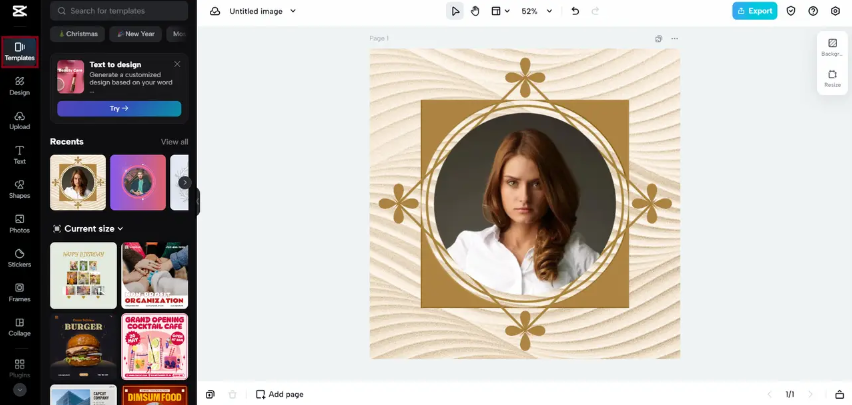
Framing your circular images
If you want to add an extra layer of style to your circular crops, CapCut’s framing options provide numerous possibilities. The platform offers an extensive collection of frames in various materials and styles—from natural wood textures to modern geometric patterns and elegant floral designs. These frames can enhance your circular images, making them more distinctive and tailored to your personal or brand aesthetic.
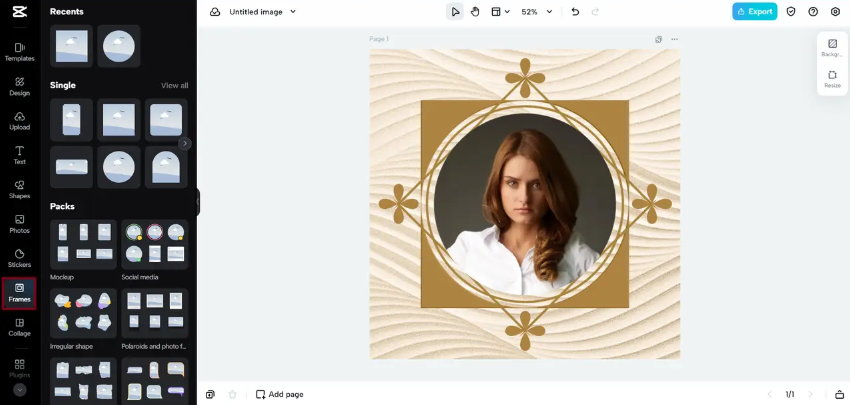
Exploring shape variations
While circles are the focus, CapCut recognizes that sometimes other shapes might better serve your creative vision. The platform offers a diverse selection of shapes including ovals, hearts, diamonds, triangles, and hexagons. This flexibility allows you to experiment with different geometric forms while maintaining the same user-friendly cropping approach.
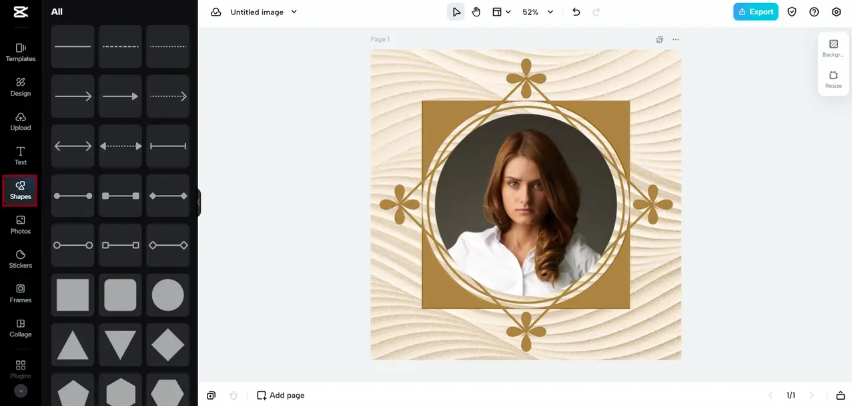
Step-by-step guide to circular cropping with CapCut
Creating circular images with CapCut involves three straightforward steps that anyone can follow, regardless of their technical expertise or previous editing experience.
Preparing your image
The first step involves accessing the CapCut platform and preparing your image for editing. You’ll need to create a free account, which can be done quickly using various registration methods including email or social media credentials. Once your account is established, uploading your images is remarkably flexible—you can import files from your computer, mobile device, or various cloud storage services including Dropbox and Google Drive.
The platform supports a convenient drag-and-drop interface that makes uploading feel natural and effortless. Mobile users can additionally utilize QR code scanning to transfer images directly from their phones to the editing environment.

Executing the circle crop
This is where the actual circular transformation happens. CapCut provides multiple pathways to achieve your circular crop, accommodating different preferences and project requirements.
If you prefer working with templates, simply navigate to the Templates section and search for “Round” or “Circle” to see available options. Once you’ve selected a template that appeals to you, replacing the placeholder image with your own photograph is as simple as dragging and dropping your file onto the template interface.
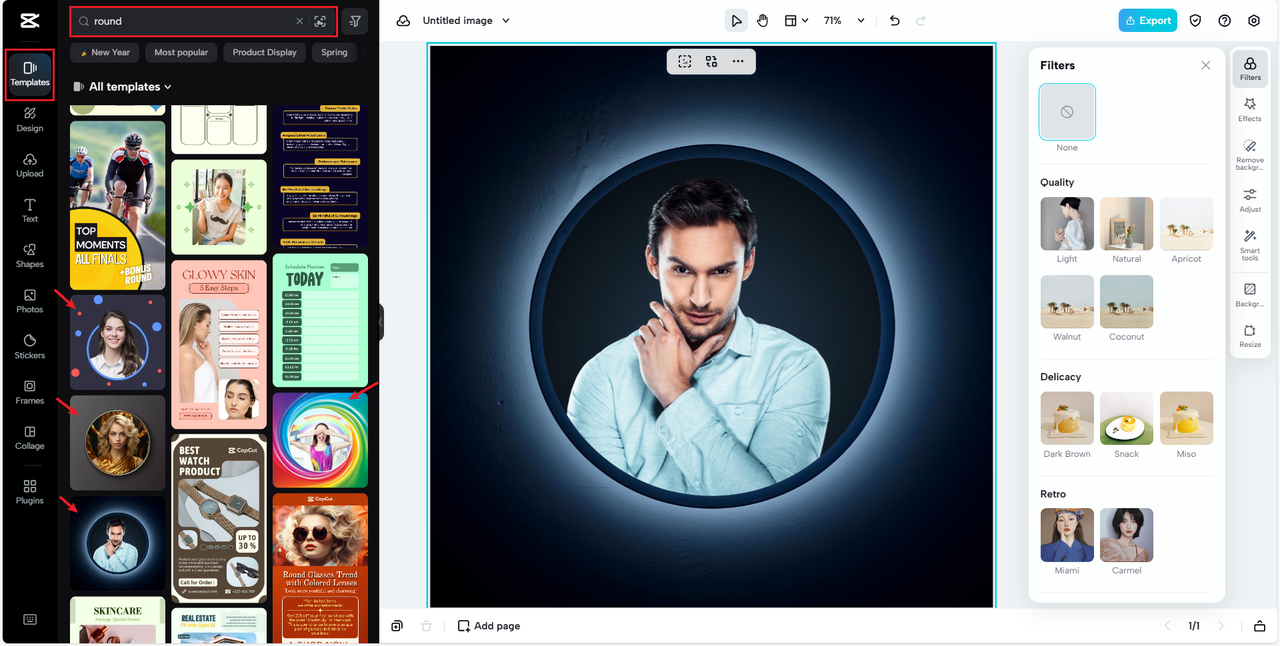
For those who want more control over the framing without background elements, the Frames option provides an excellent alternative. By selecting a circular frame from the materials panel, you can position it precisely on your canvas and then add your image within this circular boundary.
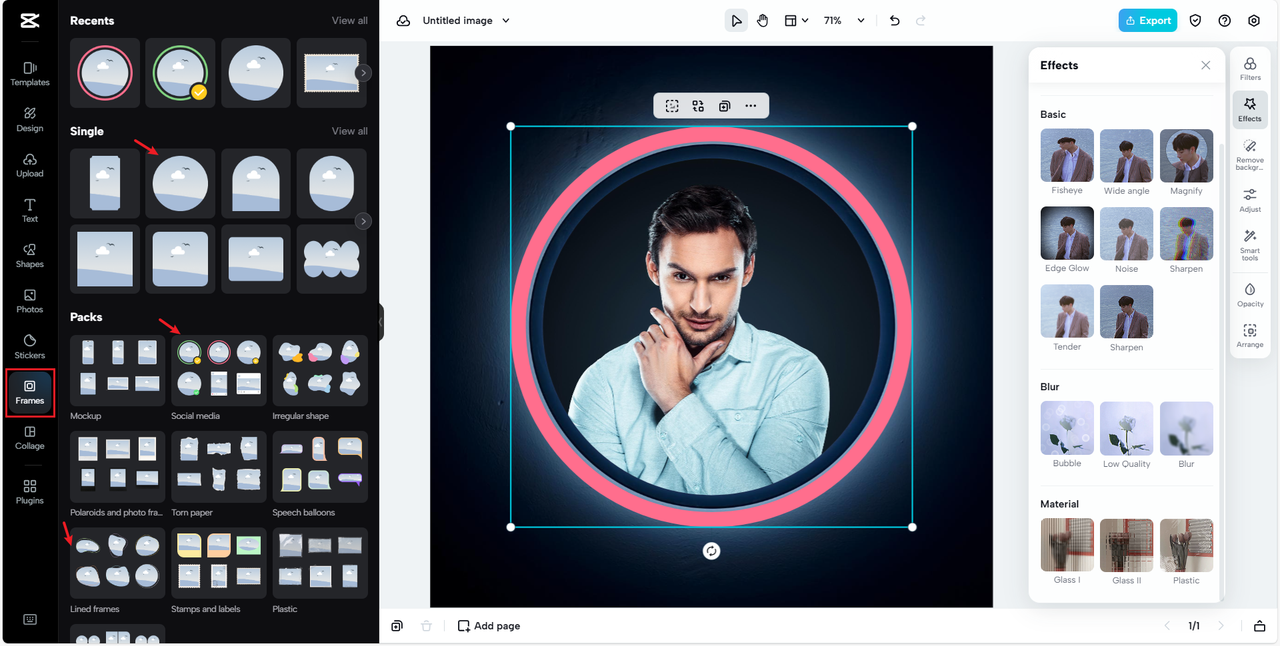
The Shapes tool offers a third approach, allowing you to select a circle shape and adjust its size and position manually before applying it to your image. This method provides the most granular control over your final circular composition.
Finalizing and exporting your creation
The final step involves saving your newly created circular image in your preferred format and quality settings. CapCut’s export interface allows you to select file format, dimensions, and resolution based on how you plan to use the image.
For maximum versatility—especially if you’ll be using your circular image on websites or in graphic designs—be sure to enable the “Transparent Background” option. This ensures your circular crop maintains its shape without being confined to a rectangular canvas with visible background color.
Once you’ve configured your export settings, simply click the download button to save your circular image to your device.
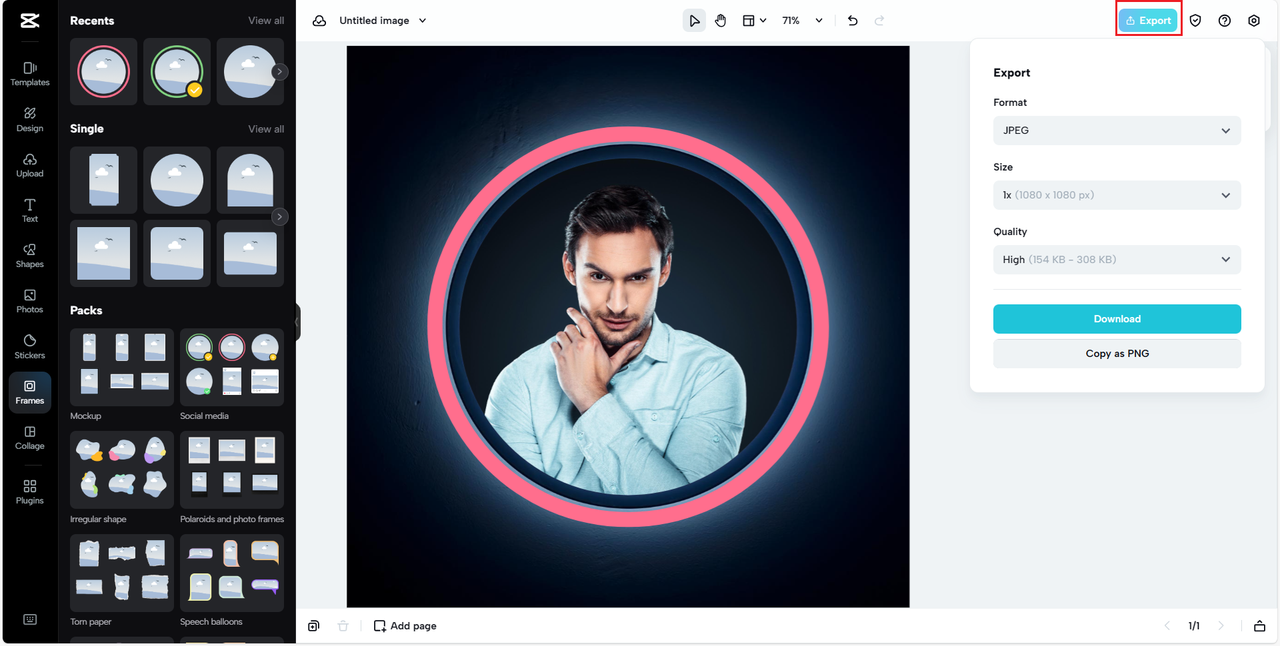
Professional techniques for better circular crops
Achieving truly outstanding circular crops involves more than just technical knowledge of the tools. These professional tips will help you create circular images that look intentionally composed and visually compelling.
Always begin by carefully examining your image before applying any crop. Consider which elements are most important and how much of the surrounding context you want to preserve. The circular format naturally emphasizes whatever falls within its boundaries, so thoughtful composition is crucial.
Subject placement within your circular frame significantly impacts the final result. For portrait photographs, generally center the subject’s face within the circle to create a balanced, engaging composition. With landscape or architectural images, identify the most interesting visual element—a distinctive tree, an elegant building detail, or a striking natural formation—and position this element as the focal point of your circular crop.
When working with group photographs, aim to center the circle around the middle of the group to ensure everyone is included proportionally. This prevents awkward cropping that might exclude important people or cut them off at uncomfortable points.

Consider the relationship between your subject and the edges of the circular frame. A tight crop that closely surrounds your main subject creates emphasis and intimacy, while a looser crop that includes more background context tells a broader story about the setting and environment.
Don’t be afraid to experiment with unconventional compositions. Off-center placement or slight tilting can create dynamic, interesting circular images that stand out from more conventional centered crops. These creative approaches work particularly well for artistic projects or when you want to convey specific emotions or perspectives.
Always prioritize image quality throughout the cropping process. Remember that cropping reduces the overall resolution of your image, so begin with the highest quality original file possible. If you need your final circular image to maintain high resolution for printing or large-scale display, avoid excessive cropping that might result in pixelation or quality degradation.
CapCut — Your all-in-one video & photo editing powerhouse! Experience AI auto-editing, realistic effects, a huge template library, and AI audio transformation. Easily create professional masterpieces and social media viral hits. Available on Desktop, Web, and Mobile App.
Creative applications for circular images
Once you’ve mastered the technical aspects of circular cropping, you’ll discover numerous creative applications for your newly shaped images across both personal and professional contexts.
Social media platforms represent the most common use for circular images. Major platforms including Facebook, Instagram, and Twitter all utilize circular profile pictures, making this an essential skill for anyone maintaining an online presence. A well-executed circular crop can significantly enhance your professional appearance on these platforms.
Circular formats also work exceptionally well for logo design and branding elements. The inherent balance and symmetry of circles make them naturally memorable and visually appealing for branding purposes. Even if you’re not designing an official logo, circular crops can create distinctive branding elements for personal projects, small businesses, or portfolio presentations.
Website designers increasingly incorporate circular elements to break up conventional rectangular layouts. Circular images can serve as team member portraits, product highlights, or purely decorative elements that add visual interest and modern flair to web pages. The contrast between circular image elements and standard rectangular content areas creates engaging visual rhythm.
Photographers and artists can use circular crops to present their work in novel ways that challenge conventional rectangular framing. A circular crop can transform an ordinary photograph into something that feels intentionally artistic and compositionally interesting. This approach encourages viewers to engage with images differently, noticing details and relationships they might overlook in standard rectangular formats.
Circular images also lend themselves beautifully to collage work and mixed media projects. Arranging multiple circular images together can create dynamic patterns and compositions that would be difficult to achieve with traditional rectangular photographs. This approach works particularly well for photo walls, digital collages, and presentation materials.
Avoiding common circular cropping mistakes
While circular cropping is relatively straightforward, several common mistakes can undermine your results. Being aware of these potential pitfalls will help you avoid frustration and achieve better outcomes.
One frequent error involves cropping too tightly around your subject. While it’s tempting to zoom in closely to emphasize your main subject, excessive tightness can make images feel constricted and uncomfortable. Leave adequate breathing space around your subject to create a more balanced and pleasant composition.
Always consider what will be eliminated when you apply a circular crop. The corners of your original image will be discarded, so ensure there aren’t important elements in these areas that you’ll miss in the final circular version. Preview your crop carefully before finalizing to avoid accidentally removing significant content.
Image quality considerations are crucial when cropping. Since cropping reduces resolution, starting with low-quality images will likely result in pixelated or blurry circular crops. Always work with the highest resolution originals available, and be mindful of how much you’re cropping relative to your final size requirements.
Proper circle placement significantly affects your final composition. Avoid simply accepting the default centered position without consideration—sometimes off-center placement creates more dynamic and interesting images. Experiment with different placements to find the most compelling composition for each specific image.
Remember that most circle cropping tools allow you to adjust the size of the circular crop area relative to your image. Don’t limit yourself to the default circle size—experiment with different proportions to see what works best for each photograph. Larger circles include more context, while smaller circles create more intimate, focused compositions.
Expanding your circular editing skills
As you become more comfortable with basic circular cropping, you might want to explore additional techniques that can enhance your circular images further.
Many editing platforms, including CapCut, offer border customization options for your circular crops. Beyond simple lines, you can experiment with textured borders, colored outlines, or decorative patterns that complement your image content. These borders can help your circular images stand out even more when used in designs or presentations.
Consider combining circular crops with other editing effects for more distinctive results. Subtle filters, color adjustments, or lighting effects can enhance your circular images without overwhelming the central composition. The key is to use these enhancements sparingly—they should support your image rather than dominate it.
For advanced projects, you might explore layering multiple circular images to create complex compositions. This technique works particularly well for creating mood boards, design presentations, or artistic collages. The consistent circular format creates visual harmony even when combining disparate images.
If you’re creating circular images for specific platforms, familiarize yourself with the optimal dimensions and specifications for each. Different social media platforms may have slightly different requirements for profile pictures, and understanding these nuances will ensure your circular crops look their best everywhere they appear.
Conclusion: Embracing the circular format
Circular image cropping represents more than just a technical skill—it’s a creative approach that can transform how you present and perceive photographs. The circular format offers unique compositional opportunities that differ significantly from traditional rectangular cropping, encouraging you to think differently about focus, balance, and visual storytelling.
As you’ve seen throughout this guide, modern tools like CapCut have made circular cropping accessible to everyone, regardless of previous editing experience. The process is straightforward, intuitive, and offers immediate creative rewards. With practice, you’ll develop an eye for circular composition that enhances your photographs across various applications.
The true value of learning to crop a circle effectively extends beyond the technical process itself. This skill empowers you to present your images more intentionally, whether you’re updating social media profiles, creating branding materials, or simply exploring new ways to enjoy your photographs. The circular format’s inherent balance and focus can reveal qualities in your images that might remain hidden in traditional rectangular presentations.
Remember that like any creative skill, circular cropping improves with practice and experimentation. Don’t hesitate to try different approaches, play with various compositions, and discover what works best for your specific images and purposes. Each photograph presents unique opportunities for circular presentation, and part of the enjoyment comes from exploring these possibilities.
Now that you understand the process, benefits, and applications of circular cropping, you’re ready to begin transforming your own images. Start with photographs that have clear focal points, experiment with different cropping approaches, and gradually expand your skills to more complex compositions. With the guidance provided here and the powerful tools available in platforms like CapCut, you’ll soon be creating stunning circular images that enhance your photographic presentation across all your projects and platforms.
Some images courtesy of CapCut
 TOOL HUNTER
TOOL HUNTER



